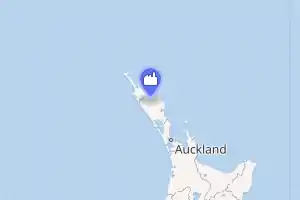Ngawha geothermal field
The Ngawha geothermal field is a geothermal area in the North Island of New Zealand. It is situated approximately 5 km east of Kaikohe and is centred on the village of Ngawha Springs. The field covers an area of around 25 km² and as such, is much smaller than the other major high-temperature geothermal field in New Zealand, the Taupo Volcanic Zone. The hot springs arising in this area are slightly acidic and are rich in ammonia, bicarbonate, boron and mercury, which is not typical of other springs in New Zealand.[1]
| Ngawha Power Station | |
|---|---|

| |
| Country | New Zealand |
| Location | Northland |
| Coordinates | 35°25′03″S 173°51′07″E |
| Status | Operational |
| Commission date | 1998, 2008 |
| Owner(s) | Top Energy |
| Power generation | |
| Nameplate capacity | 25 MW |
Ngawha Power Station

The Ngawha geothermal power station is owned and operated by Top Energy, and utilises binary cycle technology manufactured by Ormat Industries.
The power station opened in 1998 with a generating capacity of about 8MW.[1] The Ngawha Power Station was the first power station to come into operation via a resource consent applied for and issued under the Resource Management Act 1991.[2] In 2008, the plant was expanded, increasing the capacity to 25MW and allowing the power station to provide 70% of Northland's electricity.[3] In 2015, consents were granted for expansion with a further 50 MW of generation,[4] with work beginning in late 2017 - and expected to be complete by 2021.[5]
References
- "Northland Regional Council report on Environmental Monitoring : 2001-2002". Northland Regional Council. Archived from the original on 15 October 2008.
- "Regulatory Settings". New Zealand Geothermal Association. Archived from the original on 23 May 2010.
- Top Energy (21 May 2007). "Ngawha generator secured in local ownership" (Press release). Retrieved 15 August 2011.
- Top Energy (4 April 2016). "Power station consents granted" (Press release).
- "Ngawha power station drives Top Energy revenue..." Northern Advocate. 4 July 2018. Retrieved 29 July 2018.